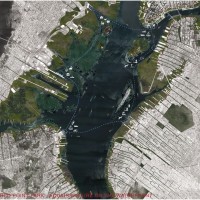Saving New York: a radical plan for rising waters
Sorry to say that we told you so, but landscape architects, architects and urbanists have been thinking for a while about how to protect New York from the terrible devastation brought on by climate change. Hurricane Sandy was a taste of what we might face in the coming decades. Sandy has brought into terrible relief just how vulnerable New York is, and how its current infrastructure is not enough.
In 2011 we showed a project called Swimming to Manhattan at the New York Center for Architecture. Jacques Abelman, Txell Blanco Diaz, Simona Serafino, Egle Suminskaite, and Marit Janse collaborated to present Red Point Parks, a vision for future development around New York’s Upper Bay, in a future where the sea has risen over 3 meters.
Swimming to Manhattan: Red Point Parks
Climate change demands a radical adaptation strategy around the Upper Bay. Our point of departure is water quality. Currently, combined sewage outflows contaminate the bay, and the water level may rise from three to five meters in the future, creating further ecological and infrastructural challenges. Our proposal is the Red Point Park public pier system.
Red Point Parks are a network of access points around the altered urban edge of the renamed Central Bay. Wetlands now occupy the flood zones, creating a living storm buffer. Some buildings have been preserved by stripping their first floors and strengthening the foundations. New piers extend from the access points through eelgrass and fish nursery zones, into deeper waters where oyster reefs have been re-established. Five new transport hubs create a water highway around the bay, giving way to a quieter zone in the center. The restored estuary ecology supports a variety of programs, from scuba diving and windsurfing to new museums and restaurants. In addition there are small artificial beaches at Governor’s Island and the shallows facing Brooklyn. The greenline network connects inner urban areas to the bay and absorbs rain water, diverting it from the sewage system. It is easy to bike or walk along these channels to reach the water’s edge. Channels widen at the end to allow the tides to enter the system.
The aquapuncture of the Red Point Parks responds to climate change to transform the city, creating a new urban edge and a living estuary whose heart is pristine water. In this sense, the entire bay functions as a park.
[portfolio_slideshow]

